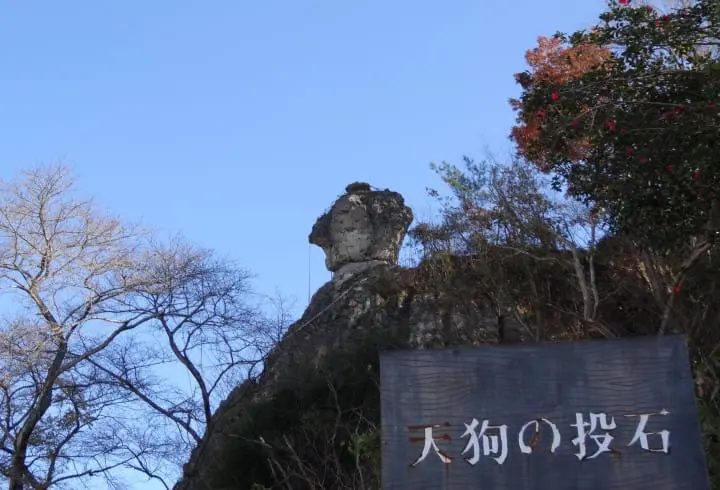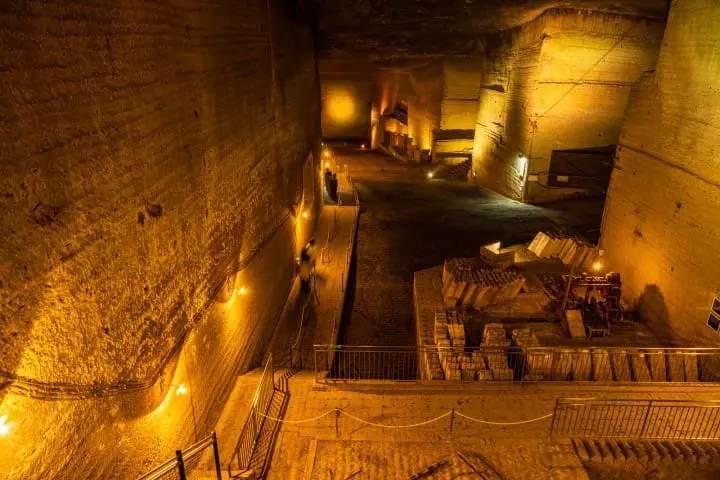Oya-ji Temple, Tochigi - The Oldest Buddhist Stone Reliefs In Japan

Tochigi Prefecture’s Oya Temple is a superb temple that was carved into the side of a rock cliff and preserves the oldest Buddhist stone reliefs in Japan. A giant statue of Kannon, the Goddess of Mercy, is located on the temple grounds.
Oya-ji Temple, located in the Oya ("Great Valley") district of Tochigi Prefecture, is over 1,200 years old being founded in 810 by the famous priest Kukai (Kobo Daishi) and belongs to the Tendai sect of Buddhism.

It’s the 19th temple of the thirty-three Kannon Temples of the Bando Pilgrimage and is one of the most superb of these temples. In 1954 it was designated a National Special Historic site and in 1961 a National Important Cultural Property. The temple is commonly called “Oya Kannon” temple.


My Bando Pilgrimage “Nokyocho” (pilgrim’s book) signed and stamped by the Oyaji priest.
The distinctive feature of the temple is its renowned stone relief of a Senju Kannon (the thousand-armed, thousand-eyed Goddess of Mercy) which is the temple’s main Buddhist image.

The entrance to the temple cave is concealed by a beautiful overhang and appears to merge into the rock cliff.
The temple’s other outstanding feature is its carved rock reliefs, “magaibutsu” - Buddhist images dating from the early Heian period (794 - 1185) which are the oldest such stone reliefs of the Kanto region. Besides the Senju Kannon, there are nine other Buddhist images grouped in sets of three.
During the Tokugawa period (1603-1868) Oyaji Temple underwent two reconstructions between 1625-1621 and 1704-1711 when both the Benten Hall and Kannon Hall were erected.
The Tale of Oya-ji Temple
All temples in Japan have a collection of tales or “engi” associated with their origin. The primary objective of these tales was to encourage the belief and worship of Buddhism based on miracles performed by various Buddhist divinities.

White snake directly in front of the Benzaiten structure
The tale of Oya-ji Temple involves a poisonous serpent polluting the waters and making rice fields of Oya valley unproductive. Local legends assert that Buddhist mountain monks subdued and expelled the serpent making the fields and water safe for the Oya villagers. To protect the village from future hardships the monks carved in stone the images of the Senju Kannon and the two accompanying images of Fudo and Bishamonten (two other Buddhist deities).

In the temple courtyard, you’ll find the Benzaiten structure erected on the spot where the poisonous snake had once lived along with two white snake structures. Images of Benzaiten, the goddess of wisdom and compassion, are frequently located near water and known for her powers to subdue serpents.
The Treasure House of Oya-ji Temple
Directly adjacent to the temple is the Oya-ji treasure house, a small museum documenting the history of Oya-ji and the various restoration work conducted to preserve the “magaibutsu” Buddhist rock carvings. On display are various archaeological artifacts discovered during the restoration work that date back to the Jomon period over 10,000 years ago. Included are the skeleton remains of a young male that has been carbon-dated to the very start of the Jomon period. Research has confirmed that Oyaji was inhabited by people since the Neolithic period.
Otome Hill
If you have time for a short hike (15 minutes), check out Otome Hill which has been designated a national spot of scenic beauty. The only other such spot so designated in Tochigi prefecture is Nikko’s famous Kegon Falls.

The origin of the name “Otome Hill” (literally “stop”) is interesting. During the Edo period (1603-1868), the area was closed to the general public in autumn when the Imperial prince used to come here to gather matsutake, a highly prized and valuable mushroom. Today, just one matsutake can sell for hundreds of dollars. The vertical stone monument at Otome Hill’s peak is to commemorate the visit of Emperor Taisho.

From the top you can enjoy excellent views of the rock cliffs of Oya.
The Heiwa Kannon Statue

As you proceed along the path made of Oya stone from the bus stop, you’ll soon come to Oya Park, an area surrounded by 80-foot high cliffs. The massive Heiwa Kannon (The Kannon of Peace) Statue you'll find here may remind you of ancient Egyptian stone structures. It stands a soaring 88 feet (27 meters) and the giant stone walls surrounding the statue create a spectacular sight.

Originally, at his own expense, a local Oya carpenter took on the challenge of carving a gigantic Kannon as a memorial to his brother and others who died in World War II. However, deeply in debt, he was forced to abandon the project in 1950. The Tourist Association of Oya provided funds to continue the work and the statue was finally completed in 1956. Stairs allow you to climb up to a platform behind the head of the statue which also provides excellent views of the area as well as Oya Temple and Oya Park.

Off to the left side of the Kannon statue and mostly unnoticed is a stone memorial dedicated to the souls of those who died in World War II. As you leave Oya Park, you’ll find informative signs in Japanese and English on the way to Oya Temple which are well worth reading before arriving at Oya Temple only a couple minutes’ walk away.
Understanding Kannon
Since you’ll encounter Kannon statues throughout Japan such as the huge Tokyo Bay Kannon or the Utsuki Kannon, both in Chiba Prefecture, it’s worth having a basic knowledge of this Buddhist bodhisattva (one who is motivated by great compassion). The Chinese characters for Kannon are 観音, two characters which literally mean “see” and “sounds” suggesting that the Kannon, the Goddess of Mercy, constantly listens for sounds of suffering and seeks to save humanity from distress and afflictions.
From the early seventh century, Buddhist mountain monks worshiped Kannon believing in its valuable powers to drive away evil and bring good fortune. In order to save those who are suffering, Kannon takes on thirty-three different manifestations which correspondent to the thirty-three temples of the Bando Pilgrimage. The most common manifestations are:
• Sho-Kannon or original form.
• Senju-Kannon or thousand-arm Kannon able to help many at one time.
• Juichi Kannon or eleven-faced Kannon who sees and hears all.
• Bato-Kannon or horse headed Kannon, the savior of animals.
No doubt you’ll notice that the Oya Temple Senju Kannon actually does not have the thousand-arms or eyes. The Oya Kannon’s 40 arms each represent 25 worlds, and 40 times 25 equals 1000. Each arm contains one eye, again totaling 1000 eyes. If you see an eleven-headed Kannon, the Kannon statue will have a crown with ten smaller heads.
Tengu Rock

As you walk along the path to the Kannon Peace Statue, look up to your right and you’ll see a large boulder perched on the cliff. This is “Rock thrown by the Tengu“. Tengu are legendary creatures with great powers, usually portrayed as goblins with long noses.
Local folklore says that a Tengu threw the rock and used his mystic powers to make it land at the very peak of the cliff.
Surrounding Sites of Interest in the Oya Area
Definitely do not miss visiting the Oya History Museum and the Oya underground quarry which are only a short walk from Oya-ji Temple. See our article on the Oya History Museum for details.
Access to Oya-ji Temple
Oya Temple is about 7 kilometers northwest of Utsunomiya Station. From the station take the Kanto Bus bound for Oya, about a 30 minute ride, and get off at the Oya Kannon-mae (大谷観音前) bus stop. It’s a two minute walk to the temple and the Peace Kannon. As you ride the bus into the town of Oya, you will soon notice rock cliffs on both sides of the road as well as many buildings and walls made out of Oya stone.
From the bus stop walk back about 100 meters in the direction the bus came and you’ll see a public parking lot on your right and the entrance to the Oya Park and the Peace Kannon Statue on your left, as well as a public bathroom. Proceed ahead between the rock cliffs to Oya Park and Oya Temple.










































![[2026] Top 5 Strawberry Picking Spots in Tokushima, Naruto| Farms and Access Guide for January to May](https://resources.matcha-jp.com/resize/720x2000/2025/03/06-227165.webp)


